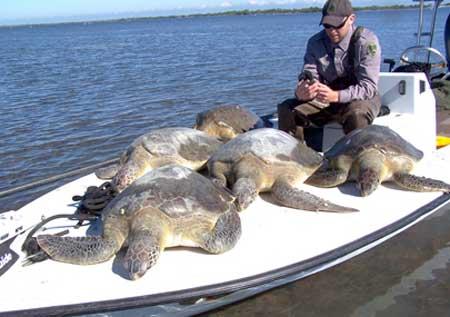The weather has created plenty of problems all across the country in recent weeks, and the frigid temperatures in Florida affected more than the citrus crop. Thousands of sea turtles were rescued from the unusually cold water, many of them at Canaveral National Seashore.
Five species of sea turtles occur in the waters of Canaveral National Seashore, and all are federally classified as threatened or endangered. Mosquito Lagoon in the park is a major nursery area for juvenile green and loggerhead sea turtles, but the unusually cold temperatures earlier this month created major problems for the animals—and a big challenge for employees and volunteers from a host of agencies and organizations. According to the Florida Fish and Wildlife Conservation Commission,
Unlike marine mammals such as dolphins or manatees, sea turtles cannot keep themselves warm—their body temperature varies with the surrounding water. As water temperatures drop in coastal lagoons and bays, many sea turtles will move through inlets and passes to warmer water offshore or to the south.
A very rapid drop in the air and water temperature can trap sea turtles in the shallower coastal waters. They can become inactive, settling close to the bottom or in deeper water within the estuary.
…at very low temperatures (less than 50º F) these cold-blooded animals may become lethargic or stunned.… A cold-stunned turtle is not able to move very well, if at all. They may be pushed by strong winds or currents onto the shore or into marsh areas, or just float at the water's surface. If left unaided, most of these turtles would not have survived. Many would have been attacked by predators, been hit by boats or simply drowned.
The problem became apparent in the park on January 4 and 5, when Ranger Rob Romer found the first three turtles that were in trouble. According to a park report,
With an extended forecast of unusually cold weather, the interagency sea turtle rescue network was notified and the incident command system was put into effect.
Over the next few days, water temperatures dropped as low as four degrees C in Mosquito Lagoon. Many additional strandings were reported in the Indian and Banana rivers near the park. Hundreds of stunned sea turtles were washing ashore each day.In an extraordinary interagency effort, the park and many other groups, including NASA, USFWS, Florida Fish and Wildlife Conservation Commission, U.S. Air Force, St. Johns River Water Management District and numerous volunteers, took to the water to retrieve the stranded turtles.
These were transported to several processing facilities, the primary one being established at Merritt Island National Wildlife Refuge, where basic measurements were taken before shipping the turtles to more adequate holding facilities such as Sea World, Marineland and other aquaria and rehabilitation centers.
Visitors frequently remark to rangers and other employees, "I sure wish I had your job," but projects like this one are a good reminder that getting paid to spend time outdoors has both ups and downs, and this was cold, wet work.
Brutal weather conditions hampered operations on January 9th, causing park employees and others to rummage through drawers seeking little-used long-underwear, coats and gloves. Operations were actually suspended for a day to ensure human safety.
Similar situations have occurred in the past, but never at the magnitude of this year's incident. The largest number of turtles collected in the park in previous years was 256; this year's count:
Over 2,100 sea turtles, mostly green with a few loggerheads and a single hawksbill, were retrieved from Mosquito Lagoon and nearby waters.
As the water warms and the turtles revive, they are being released back into the wild. A final count state-wide of the turtles involved is in the "thousands," and according to a spokesman for the Florida Fish and Wildlife Conservation Commission (FWC), nearly 80 percent of the affected sea turtles were rescued and released back to the wild throughout the state.
There was a plus for scientists from the situation—an unexpected wealth of information. After the condition of the turtles was assessed, they were tagged and useful data on the animals was obtained.
Scientists will use genetic information obtained from the turtles to better understand where these turtles originally hatched. Biologists also will collect valuable information on size, geographic distribution, health status and other factors. Tags on released turtles will provide biologists with useful information for years to come, including where they travel and their rate of survival.
"We've been able to tag many more turtles than ever before, which enables us to learn about their biology," said Dr. Blair Witherington, FWC biologist. "It's been a great opportunity for data collection; it's unprecedented to have access to so many turtles at one time."
The park website includes additional information about sea turtles, and for the past several years, the park has offered a popular series of Turtle Watch programs in the early summer.




Add comment